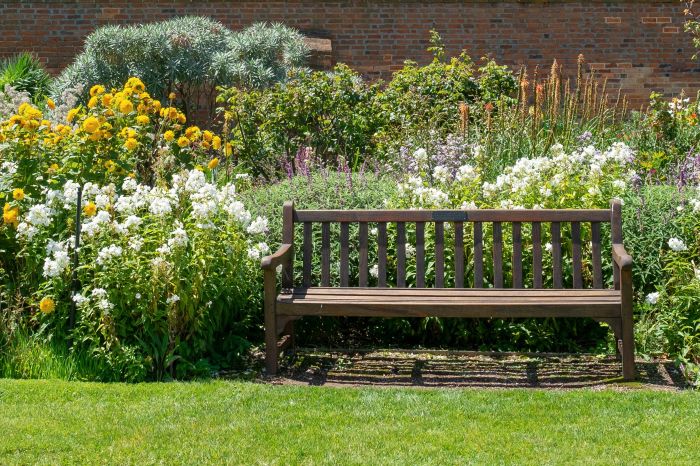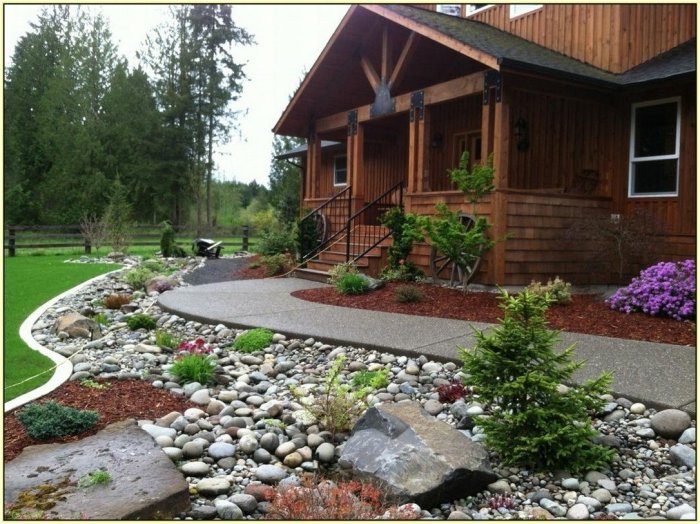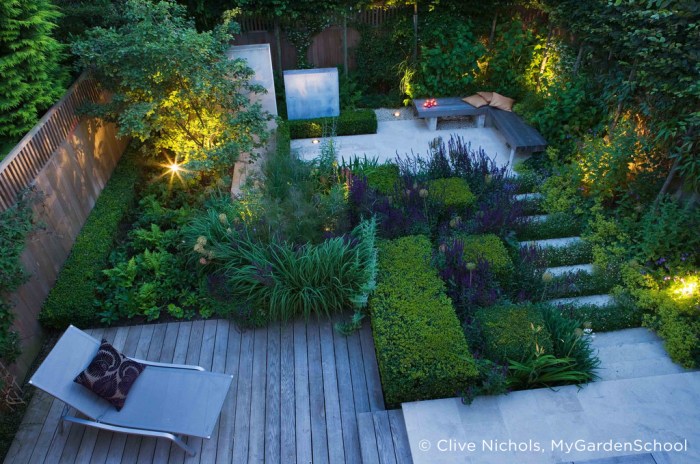Transforming a blank space into a vibrant, thriving garden is a rewarding journey, even for complete beginners. This guide provides a step-by-step approach, demystifying the process of garden design and plant care. From planning the perfect layout and selecting the right plants to mastering essential maintenance techniques, we’ll equip you with the knowledge and confidence to create a beautiful outdoor oasis.
We’ll cover everything from understanding soil types and sunlight requirements to choosing between annuals, biennials, and perennials. Learn practical tips for selecting easy-to-maintain plants, starting seeds indoors, and combating common garden pests and diseases. By the end, you’ll possess the skills to nurture your garden’s growth and enjoy its beauty for years to come.
Planning Your Dream Garden

Creating a beautiful garden begins with careful planning. This involves considering several key factors, from the overall design and layout to the specific needs of the plants you choose. By thoughtfully addressing these aspects, you’ll set the stage for a thriving and visually appealing garden.
Garden Layout Design
A well-designed garden layout maximizes space and showcases your plants to their best advantage. Consider dividing your garden into functional areas, such as a vegetable patch, a flower bed, or a seating area. The following table provides a sample layout, easily adaptable to your own space and preferences. Remember, this is a suggestion; feel free to adjust it based on your specific needs and available sunlight.
| Area | Plants | Sunlight | Soil Type |
|---|---|---|---|
| Vegetable Patch | Tomatoes, peppers, lettuce, zucchini | Full sun (6-8 hours) | Well-drained loam |
| Flower Bed (Sun Lovers) | Sunflowers, marigolds, zinnias, lavender | Full sun (6-8 hours) | Well-drained sandy loam |
| Flower Bed (Shade Lovers) | Hostas, ferns, impatiens, begonias | Partial shade (4-6 hours) | Moist, well-drained soil |
| Herb Garden | Basil, rosemary, thyme, oregano | Full sun (6-8 hours) | Well-drained, slightly alkaline soil |
Soil Types and Amendments
Understanding your soil type is crucial for successful gardening. Different plants have different needs. For beginners, well-drained loam is ideal. Loam is a balanced mix of sand, silt, and clay, providing good drainage and aeration. Sandy soils drain quickly, potentially leading to dryness, while clay soils retain too much water, which can suffocate roots.
If your soil is not ideal, you can amend it to improve its structure and fertility. For sandy soil, add organic matter like compost or well-rotted manure to improve water retention. For clay soil, incorporate organic matter to improve drainage and aeration. Regular soil testing can help you monitor its condition and guide your amendment efforts. Soil testing kits are readily available at most garden centers.
Sunlight and Shade Considerations
Sunlight is essential for photosynthesis, the process by which plants produce their food. Most vegetables and flowering plants need at least 6 hours of direct sunlight daily. However, some plants thrive in partial shade or full shade.
Plants that thrive in full sun (6-8 hours) include sunflowers, tomatoes, and lavender. Plants that prefer partial shade (4-6 hours) include hostas, ferns, and impatiens. Shade-loving plants (less than 4 hours) include astilbe and ferns. Carefully consider the amount of sunlight your garden receives throughout the day when choosing plants. Observe your garden at different times of the day to determine sunny and shady areas.
Essential Gardening Tools for Beginners
Having the right tools makes gardening easier and more enjoyable. Start with these essentials:
- Gardening gloves: Protect your hands from dirt, thorns, and insects.
- Hand trowel: For digging small holes and transplanting seedlings.
- Garden fork: For loosening soil and aerating beds.
- Watering can: For providing consistent moisture to your plants.
- Pruning shears: For trimming dead or overgrown branches.
- Gardening hose with adjustable nozzle: For efficient watering.
Choosing the Right Plants

Selecting the right plants is crucial for a thriving and beautiful garden. Understanding the different types of plants and their needs will significantly impact your success. This section will guide you through choosing plants suited to your gardening experience and aesthetic preferences.
Annuals, Biennials, and Perennials: A Comparison
Annuals, biennials, and perennials differ fundamentally in their life cycles and, consequently, their care requirements. Understanding these differences is key to planning a garden that blooms continuously throughout the growing season.
Annuals complete their entire life cycle – from seed to flower to seed production – within a single growing season. Examples include zinnias, petunias, and sunflowers. They provide a burst of color but require replanting each year. Biennials, on the other hand, take two years to complete their life cycle. They typically produce foliage the first year and flowers the second before dying. Examples include foxgloves and sweet williams. Perennials, conversely, live for three or more years, returning year after year. Many perennials offer continuous bloom or interesting foliage throughout the seasons. Examples include hostas, coneflowers, and lavender. Annuals require minimal care beyond regular watering and fertilizing, while perennials may need dividing every few years to prevent overcrowding. Biennials require minimal care in their first year, with more attention needed during the flowering stage in their second year.
Designing a Vibrant Flower Bed
A successful flower bed combines plants with varying heights, colors, and textures to create visual interest throughout the growing season. Consider incorporating a mix of annuals, biennials, and perennials to achieve continuous bloom.
For example, a vibrant flower bed could feature tall purple delphiniums (perennial) as a backdrop, complemented by medium-height orange calendula (annual) for a bold contrast. Lower-growing blue lobelia (annual) could fill in the gaps at the base, creating a cascade of color. The texture contrast could be further enhanced by including plants with different leaf shapes and sizes, such as feathery ferns (perennial) or broad-leaved hostas (perennial). This combination creates a visually appealing and dynamic flower bed with a variety of colors and textures. The delphiniums provide height and a striking purple hue, while the calendula adds a vibrant orange splash. The lobelia adds a cool blue to the mix and the ferns provide textural contrast.
Selecting Easy-to-Maintain Plants for Beginners
Choosing easy-to-maintain plants is essential for beginner gardeners. Focus on plants known for their resilience and adaptability to your local climate and soil conditions. Many low-maintenance perennials, such as lavender, sedum, and coneflowers, require minimal care once established. These plants often tolerate drought and poor soil conditions better than more delicate varieties. Look for plants labeled as “low maintenance” or “drought-tolerant” at your local nursery. Before planting, amend your soil with compost to improve drainage and fertility. This will provide a good foundation for healthy plant growth and reduce the need for excessive fertilization and watering.
Starting Seeds Indoors vs. Buying Established Plants
Starting seeds indoors offers the advantage of a wider selection and potential cost savings, but it requires more time and effort. You need to provide the right conditions for germination and seedling growth, including appropriate lighting, temperature, and humidity. Buying established plants from a nursery offers convenience and a higher success rate, but can be more expensive. Established plants are already rooted and growing, reducing the risk of failure. However, the selection might be limited to what is currently available at the nursery. The choice depends on your gardening experience and available time. If you have limited time or experience, buying established plants is the more practical approach. For those with more time and a desire for a wider plant selection, starting seeds indoors is a rewarding option.
Garden Maintenance and Care

Maintaining a thriving garden requires consistent effort and attention. Regular care ensures the health and beauty of your plants, maximizing their growth and bloom. This section Artikels a practical approach to garden maintenance, encompassing watering techniques, pest and disease management, and essential pruning practices.
Monthly Garden Maintenance Schedule
A well-structured schedule simplifies garden maintenance and prevents tasks from being overlooked. The following table provides a suggested monthly plan, adaptable to your specific garden needs and climate. Remember to adjust based on your local weather conditions and plant types.
| Month | Watering | Weeding & Mulching | Pest & Disease Control |
|---|---|---|---|
| January | Reduce watering frequency; check for frost damage | Remove winter debris; apply mulch where needed | Inspect plants for signs of disease or pest infestation |
| February | Increase watering slightly as temperatures rise | Weed around plants; replenish mulch | Monitor for early signs of pests; implement preventative measures |
| March | Water more frequently; monitor soil moisture | Regular weeding; top up mulch | Continue monitoring; apply appropriate treatments if needed |
| April | Water deeply and regularly; consider supplemental irrigation | Consistent weeding; add fresh mulch | Regular inspection; address any infestations promptly |
| May | Water as needed; adjust based on rainfall | Ongoing weeding; maintain mulch layer | Monitor for pests and diseases; use natural controls where possible |
| June | Water deeply, especially during hot spells | Weed diligently; refresh mulch as needed | Regular pest and disease checks; implement appropriate control measures |
| July | Frequent watering; consider early morning or evening watering to minimize evaporation | Consistent weeding; mulch helps retain moisture | Monitor carefully; address any problems immediately |
| August | Water deeply and regularly; monitor soil moisture closely | Weed and mulch regularly to maintain soil health | Continue monitoring; apply preventative measures where necessary |
| September | Reduce watering frequency; prepare plants for cooler weather | Remove weeds; replenish mulch for winter protection | Inspect plants for any late-season problems |
| October | Reduce watering; monitor for frost | Clean up fallen leaves and debris; prepare for winter | Final inspection for any lingering pests or diseases |
| November | Minimal watering; protect plants from frost | Winterize the garden; remove dead plants | Minimal intervention; prepare for next season |
| December | Minimal watering; protect plants from harsh weather | Protect vulnerable plants from frost; clear debris | Plan for next season’s pest and disease control |
Watering Techniques
Effective watering is crucial for plant health. Different methods offer varying advantages and disadvantages.
Drip irrigation delivers water directly to the roots, minimizing water waste and evaporation. This method is particularly efficient for established gardens and large planting areas. Hand watering, while labor-intensive, allows for precise control and observation of plant moisture levels. It’s ideal for smaller gardens or individual plants requiring specific attention. Choosing the right method depends on the size of your garden, the types of plants you are growing, and your available resources.
Common Garden Pests and Diseases
Many common garden pests and diseases can be effectively managed using natural methods. For example, aphids, small sap-sucking insects, can often be controlled by introducing ladybugs, their natural predator. Powdery mildew, a fungal disease, can be treated with a baking soda solution. Early detection and preventative measures are key to minimizing damage. Always identify the specific pest or disease before applying any treatment.
Pruning and Deadheading
Pruning and deadheading are essential for maintaining plant health and promoting abundant blooms. Pruning involves removing unwanted branches or stems to shape the plant, encourage growth, and remove diseased or dead parts. Deadheading involves removing spent flowers, preventing the plant from producing seeds and encouraging more blooms. Different plants require different pruning techniques; research the specific needs of your plants before beginning. For example, roses benefit from regular pruning to encourage new growth and abundant flowers, while many perennials only require deadheading.
Last Word

Creating a beautiful garden is an ongoing process of learning and adaptation, but with the right knowledge and a touch of patience, the rewards are immeasurable. This guide has provided a foundational understanding of garden design and maintenance, empowering you to embark on your gardening journey with confidence. Remember to enjoy the process, experiment with different plants and techniques, and watch your garden flourish under your care. The beauty you create will be a testament to your dedication and effort.